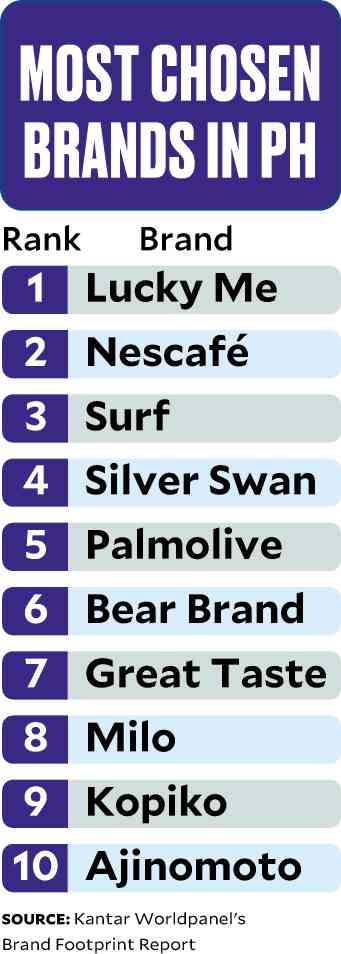Lucky Lucky Me
Instant noodle brand Lucky Me has remained the most chosen brand in the Philippines for the third straight year.
According to Brand Footprint, Kantar Worldpanel’s annual report and its ranking of most chosen brands across the world, Lucky Me managed to be chosen by shoppers on the shelves 812 million times.
Number 1 brand, Lucky Me, has the most number of buying households, reaching 98 percent of Filipino homes.
At the same, it is being purchased 36 times in a year.
The brand was followed by Nescafé and Surf that are also the most chosen brands in beverage and home care, respectively.
Next on the list are Silver Swan and Palmolive.
Bear Brand, meanwhile, gained presence in 87 percent of Filipino households and climbed two positions to become the sixth most chosen brand in the country.
Completing the list are Great Taste, Milo, Kopiko and Ajinomoto.
The Brand Footprint ranking measures how many times any fast moving consumer good brand is bought at the point of sale.
It measures how many households bought each brand and how many times they did it within one year.
The most chosen brands on the shelves globally and in any region or country make up the different rankings included in the report.
In the Philippines, the study analyzed a total of 17 billion shopper decisions of 23 million Filipino households, covering 530 brands in 2017.
Although many of the most chosen brands purchased by Filipinos are food and drink products, there are also health and beauty and home care brands in the ranking.
Palmolive, Creamsilk and Safeguard are the three most chosen brands in the health and beauty sector while the top three brands in home care are Surf, Downy and Champion.
The Brand Footprint ranking shows that most of the growing brands enlarged their shopper base.
Alex Duterrage, general manager of Kantar Worldpanel Philippines, said brands wanting to grow had to prioritize finding new shoppers to buy the brand.
The 2018 edition of Kantar Worldpanel’s Brand Footprint report, meanwhile, said there were 17 fast-moving consumer goods brands that are chosen by consumers more than one billion times a year globally.
Coca-Cola is the world’s most chosen brand, picked from the shelves 5.8 billion times in a year.
Colgate and Maggi both achieved podium positions, being also the world’s most chosen personal care and food brands.
Colgate is the only brand chosen by more than half of the global population—with a 62 percent global penetration. Maggi is the fastest-growing Top 50 brand with a global presence—with 14-percent growth in Consumer Reach Points (CRPs), which has helped the brand to rise one position to become third in the ranking this year.
Six out of the 17 brands chosen more than one billion times in a year are owned by Unilever, which leads the manufacturers ranking with 36 billion CRPs per year. Unilever’s portfolio includes Lifebuoy in 4th position and Sunsilk and Knorr among the Top 10. Dove, Lux and Sunlight are also Unilever’s brands in the billionaire club. Two Pepsico brands, Lay’s and Pepsi, jointly with Nescafé and Indomie—Indofood’s very successful brand in Asia and Africa—made the remaining positions in the Top 10.
Nestlé, P&G’s Downy, Palmolive and Sprite are the other brands that join this year the exclusive club of global brands chosen by consumers more than one billion times annually.
Josep Montserrat, CEO of Kantar Worldpanel, explained in a statement: “A lot has been said about the FMCG market being more challenging in recent times, and despite all this, 22 among the Top 50 global brands managed to be chosen by consumers more times in the last 12 months. Growth opportunities are there to be taken, and brands will need to dive deeper to find them because they may not be in the old well-known spots. Our data show that out-of-home and growing channels such as e-commerce, discounters, cash and carry outlets and convenience stores are growing faster than the overall FMCG market and it is time to invest more decisively in what consumers are asking for.”
The study also shows that local brands grew in 2017, taking 64.6 percent of all brand spend, versus global brands’ 35.4-percent share, with every 0.1 percent gained now worth $500 million.
This highlights the continued march of local brands winning share from the global players.
Global brands are stronger but still losing share in the home care, and beauty and personal care categories, taking 47 percent and 58.4 percent of global spend per sector respectively. It was only within the beverages sector that global brands are winning, having gained share from local brands three years in a row.—CONTRIBUTED

